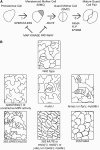Making holes in leaves: promoting cell state transitions in stomatal development
- PMID: 17468260
- PMCID: PMC1913752
- DOI: 10.1105/tpc.107.051177
Making holes in leaves: promoting cell state transitions in stomatal development
Figures

References
-
- Bergmann, D.C., Lukowitz, W., and Somerville, C.R. (2004). Stomatal development and pattern controlled by a MAPKK kinase. Science 304 1494–1497. - PubMed
-
- Hetherington, A.M., and Woodward, F.I. (2003). The role of stomata in sensing and driving environmental change. Nature 424 901–908. - PubMed
-
- Hyun, Y., and Lee, I. (2006). KIDARI, encoding a non-DNA binding bHLH protein, represses light signal transduction in Arabidopsis thaliana. Plant Mol. Biol. 61 283–296. - PubMed
MeSH terms
Substances
LinkOut - more resources
Full Text Sources

